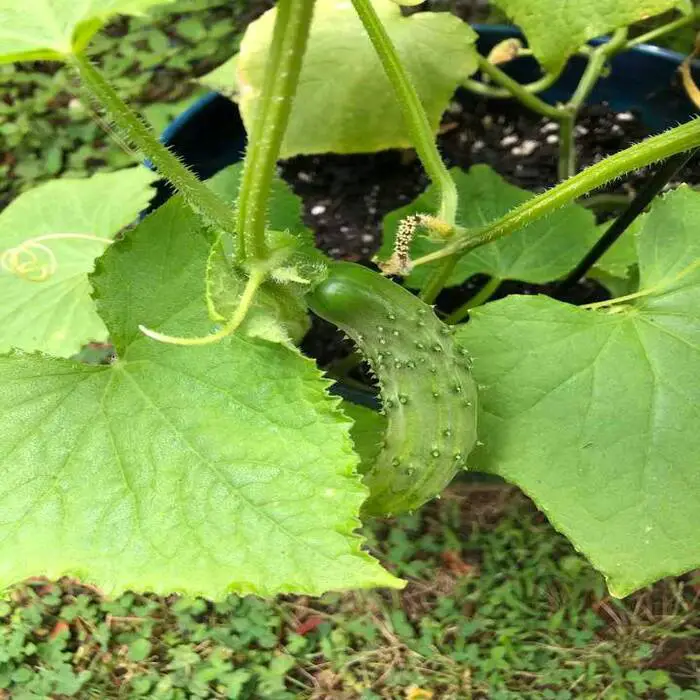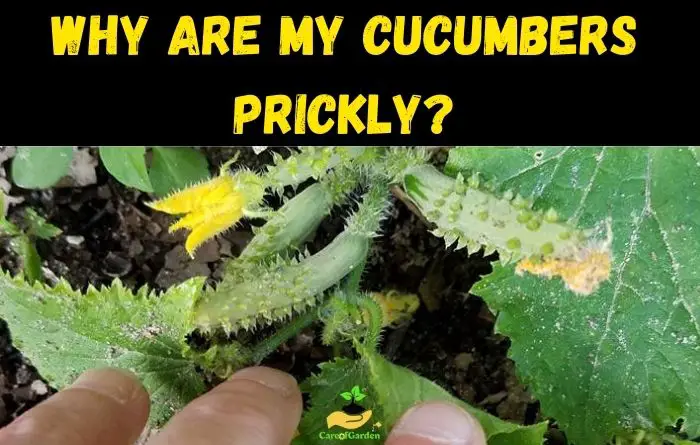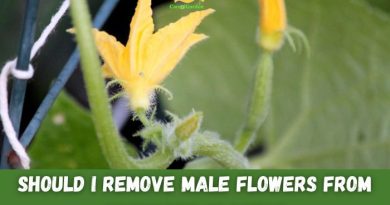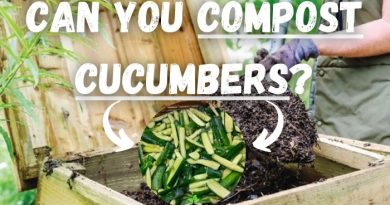Why are My Cucumbers Prickly? (3 Simple Reasons)
Have you ever experienced the disappointment of growing cucumber in your garden only to discover it covered in prickly spines? If thats the case you’re not alone. Dealing with prickly cucumbers can be quite frustrating but did you know that the explanation, behind their prickliness is genuinely intriguing?
Prickly cucumbers can be influenced by both genetics and environmental factors. Genetic makeup can dictate the presence of spines, while stressors like temperature and pests can trigger defense mechanisms in the plant, resulting in spiny cucumber growth as a protective response. When a cucumber plant is under stress due to lack of water or nutrients, it produces more trichomes as a defense mechanism, which can also lead to prickly cucumbers.
Causes of Prickly Cucumbers
Cucumbers are a popular and refreshing vegetable, but sometimes their skin can be prickly, which can be unappetizing and unpleasant to eat. In this section, I will outline some of the common causes of prickly cucumbers.
1. Genetics
One of the reasons why some cucumbers have prickly skin is because of genetics. As I research this I found out that certain cucumber varieties naturally have spines called trichomes, which can make the skin prickly to varying degrees. The presence of trichomes is a trait that can be inherited from one cucumber generation to the next.
So if a cucumber plant has pronounced trichomes it will produce cucumbers with more noticeable prickly skin.
On the other hand if you plant a seed from a cucumber with smooth skin the resulting plant will likely produce smooth-skinned cucumbers.
Cucumber-slicing varieties generally have less prickly skin compared to pickling varieties, which tend to be larger in size.
It is believed that cucumbers, which originated in India, developed prickly skin as a defense mechanism against predators, similar to how some animals have evolved horns or other protective features.
And the thorns serve, most likely, for protection from animals, so that animals could not eat the unripe fruits.
Well, when the cucumbers are ripe, animals can eat them in whole or in part, and help in distributing the seeds away from the place of cultivation.
As far as I know, this is a common trait in heirloom varieties and can be desirable for some gardeners who prefer a more rustic or traditional appearance.
Are there certain cucumber varieties that are more prone to being prickly?
Sliced varieties are usually less spiny, while pickled varieties are spinier.
Here’s a table that categorizes cucumber varieties as prickly or smooth-skinned:Cucumber Variety Type Prickly/Smooth National Pickling Pickling Prickly Boston Pickling Pickling Prickly Northern Pickling Pickling Prickly Calypso Pickling Prickly Kirby Pickling Prickly Persian (Mini) Slicing Smooth English (European) Slicing Smooth Armenian Slicing May have some prickliness Lemon Slicing Prickly Japanese Climbing Slicing Prickly Straight Eight Slicing Smooth Marketmore 76 Slicing Smooth
https://gardenerspath.com/plants/vegetables/best-pickling-cucumbers/
It’s important to note that although genetics play a role, in producing cucumbers environmental factors can also influence how pronounced the prickliness is.
2. Environmental Factors
Environmental factors can also play a role in causing cucumbers to become prickly. Temperature, humidity, and water availability can all affect the texture and appearance of the skin.
High temperatures: When cucumber plants are exposed to weather they may experience stress and develop additional trichomes as a means of protecting themselves against dehydration. These trichomes serve to minimize water loss through transpiration. They can also result in more noticeable spikes on the cucumber’s skin.
Low humidity: In situations of humidity cucumber plants may encounter stress and generate extra trichomes as a defense mechanism to safeguard against drying out. These trichomes assist in reducing water loss through transpiration. Can also lead to more prominent spikes on the cucumbers skin.
Water stress: Insufficient water supply to a cucumber plant can induce stress and trigger an increase in formation, as a protective response. When a plant is experiencing water scarcity it tends to produce trichomes in order to minimize water loss through transpiration. Consequently, this can result in distinct spikes on the surface of the cucumber.
Solution
| Environmental Factor | Solutions |
|---|---|
| High temperatures | – Cover cucumber plants with shade cloth to reduce direct sunlight – Keep cucumber plants well-watered |
| Low humidity | – Mist cucumber plants with water to raise humidity – Apply mulch around cucumber plants to retain moisture |
| Water stress | – Keep cucumber plants well-watered – Apply mulch around cucumber plants to reduce need for frequent watering |
| Pest damage | – Cover cucumber plants with row covers to prevent pests from laying eggs – Handpick pests off of plants and drop into soapy water – Use insecticides as a last resort, following instructions carefully |
3. Pest Damage
Cucumber beetles and other pests can damage the skin of cucumbers, causing them to produce more spikes as a way to protect themselves.
When the skin of a cucumber is damaged, the plant may produce more trichomes as a way to defend against further damage. This can result in more pronounced spikes on the skin of the cucumber.
Here are pests that can make cucumbers develop prickly textures including:
Cucumber beetles: Cucumber beetles, both the striped and spotted varieties are common culprits behind cucumber prickliness.
They can harm cucumber plants prompting an increase in trichomes and more spikes on the cucumber skin.
Aphids: Another type of pest that inflicts damage on cucumber plants and leads to prickliness is aphids. While several types of aphids feed on cucumbers, melon and green peach aphids are the offenders.
Similar to cucumber beetles, aphids can cause damage resulting in more prominent spikes on the cucumber skin.
Spider mites: Spider mites are pests that feed on leaves and stems of cucumber plants causing damage.
When a plant suffers from spider mite infestation it may produce trichomes as a defensive mechanism. This defense mechanism can lead to noticeable spikes, on the cucumber skin.
Solution
| Pest | Solutions |
|---|---|
| Cucumber beetles | – Handpick beetles off plants and drop into soapy water – Cover plants with row covers – Use pyrethrin-based insecticides |
| Aphids | – Blast aphids off plants with strong stream of water – Use insecticidal soap (follow instructions) – Use neem oil |
| Spider mites | – Blast spider mites off plants with strong stream of water – Use insecticidal soap (follow instructions) – Use neem oil |
How to Identify Prickly Cucumbers

When it comes to differentiating between non prickly cucumbers there are a few key characteristics you should keep an eye out for.
Here are some tips to help you distinguish between non-prickly cucumbers:
- Examine Your Cucumber Texture: Prickly cucumbers have bumpy skin that feels similar to sandpaper when touched. On the other hand, non prickly cucumbers have smoother skin that is easier to grip.
- Look for Spines: Prickly cucumbers possess evenly spaced white spines, along their skin. Initially, these spines might be hard to spot but become more noticeable when the cucumber is young. Non-prickly cucumbers don’t have any spines.
- Observe the Shape: Prickly cucumbers tend to be shorter and rounder compared to their prickly counterparts. They may also exhibit curvature or slight bending.
- Pay Attention to the Taste: Prickly cucumbers tend to be more bitter and less juicy than non-prickly cucumbers. If you take a bite of a prickly cucumber, you may notice a slightly unpleasant aftertaste.
By using these tips, you should be able to easily identify whether a cucumber is prickly or non-prickly. If you are still unsure, you can always ask your local farmer or grocer for assistance.
How to Remove the Prickles From Your Cucumbers
- Start by washing the cucumbers. Give them a rinse under running water to ensure they’re clean.
- To avoid getting pricked it’s an idea to wear gloves when handling the cucumbers. You can use either gloves or reusable ones made specifically for handling food.
- Using a brush or a soft bristled brush gently scrub the cucumbers to remove any remaining prickles. Pay attention to areas like around the stem and at the blossom end where prickles are usually more concentrated.
- Give the cucumbers another rinse, under running water to make sure all prickles are gone.
- After rinsing dry the cucumbers using a towel or paper towel.
- Using a knife cut off both ends of the cucumber – that is remove both the stem and blossom ends. This not gets rid of any remaining prickles but also gives your cucumber a fresh and clean appearance.
How can I prevent my cucumbers from becoming prickly?
From my experience and after some research, here’s a guide to help you prevent the development of prickly cucumbers:
- Select Smooth-Skinned Varieties:
- When selecting cucumber varieties go for ones that are known for their smooth skin rather than having a prickly texture.
- Look for types labeled as “slicing cucumbers” or “burpless cucumbers,” as they are less likely to have spines.
- Provide Adequate Watering:
- Ensure consistent and sufficient watering to prevent drought stress.
- You can use a soaker hose or drip irrigation system to maintain a level of moisture in the soil.
- Be careful not to overwater as this can stress the plants and lead to spines.
- Optimize Soil Conditions:
- Prepare well-draining soil enriched with organic matter to promote healthy root development and nutrient uptake.
- Regularly test soil pH and fertility levels to ensure balanced nutrient availability.
- Maintain Proper Spacing:
- Plant your cucumber seeds or seedlings at the recommended spacing allowing for sufficient air circulation and sunlight penetration between plants.
- Crowded plants can experience stress, which may contribute to the development of spines.
- Manage Temperature and Light:
- As advice, always try to plant cucumbers in an area with full sun exposure and good air circulation.
- Check temperature fluctuations and provide shade during extreme heat to reduce stress.
- Pest Inspection:
- Regularly inspect plants for signs of pests and apply appropriate treatments if necessary.
- Fertilize Wisely:
- Apply a balanced, slow-release fertilizer according to the recommended guidelines for cucumbers.
- Avoid excessive nitrogen fertilization, as it can lead to rapid growth and stress.
Can prickly cucumbers still be eaten?
Yes, prickly cucumbers can still be eaten. While the spines or prickles on the cucumber skin may be unpleasant to touch or handle, they are not harmful to eat.
In fact, many people prefer to leave the skin on their cucumbers for added nutrition and texture. However, if you find the prickliness too unpleasant, you can easily remove it by washing the cucumber thoroughly or peeling it with a vegetable peeler.
Is it normal for cucumbers to be prickly?
Yes, it is normal for some cucumber varieties to be prickly. Both pickling and slicing cucumbers can have varying degrees of prickliness, with pickling cucumbers typically having tougher and stronger spines than slicing cucumbers.
The presence of spines on cucumbers is a natural defense mechanism that helps protect the fruit from pests and environmental stressors. While some people prefer smooth-skinned cucumbers, others enjoy the added texture and flavor that prickly cucumbers provide. So, if your cucumbers are prickly, don’t worry – it’s perfectly normal!
Conclusion
In conclusion, there are several factors that can cause cucumbers to become prickly. By understanding these causes, gardeners and farmers can take steps to prevent or minimize the occurrence of prickly cucumbers.
Yes, ripe cucumbers can have spikes, also known as “prickles.” However, the degree of prickliness can vary depending on the variety and growing conditions.
Yes, proper care and management practices can help prevent cucumbers from becoming overly prickly. This includes selecting less prickly cucumber varieties, providing consistent moisture and avoiding water stress, and avoiding over-fertilization.
To minimize prickliness in cucumbers, gardeners can optimize growing conditions by selecting less prickly varieties, providing consistent moisture, avoiding water stress, and avoiding over-fertilization. Additionally, planting cucumbers in a location with good air circulation and avoiding overcrowding can help reduce the incidence of prickly cucumbers.




